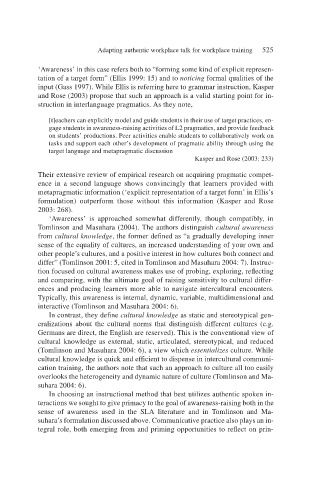Page 547 - Handbooks of Applied Linguistics Communication Competence Language and Communication Problems Practical Solutions
P. 547
Adapting authentic workplace talk for workplace training 525
‘Awareness’ in this case refers both to “forming some kind of explicit represen-
tation of a target form” (Ellis 1999: 15) and to noticing formal qualities of the
input (Gass 1997). While Ellis is referring here to grammar instruction, Kasper
and Rose (2003) propose that such an approach is a valid starting point for in-
struction in interlanguage pragmatics. As they note,
[t]eachers can explicitly model and guide students in their use of target practices, en-
gage students in awareness-raising activities of L2 pragmatics, and provide feedback
on students’ productions. Peer activities enable students to collaboratively work on
tasks and support each other’s development of pragmatic ability through using the
target language and metapragmatic discussion
Kasper and Rose (2003: 233)
Their extensive review of empirical research on acquiring pragmatic compet-
ence in a second language shows convincingly that learners provided with
metapragmatic information (‘explicit representation of a target form’ in Ellis’s
formulation) outperform those without this information (Kasper and Rose
2003: 268).
‘Awareness’ is approached somewhat differently, though compatibly, in
Tomlinson and Masuhara (2004). The authors distinguish cultural awareness
from cultural knowledge, the former defined as “a gradually developing inner
sense of the equality of cultures, an increased understanding of your own and
other people’s cultures, and a positive interest in how cultures both connect and
differ” (Tomlinson 2001: 5, cited in Tomlinson and Masuhara 2004: 7). Instruc-
tion focused on cultural awareness makes use of probing, exploring, reflecting
and comparing, with the ultimate goal of raising sensitivity to cultural differ-
ences and producing learners more able to navigate intercultural encounters.
Typically, this awareness is internal, dynamic, variable, multidimensional and
interactive (Tomlinson and Masuhara 2004: 6).
In contrast, they define cultural knowledge as static and stereotypical gen-
eralizations about the cultural norms that distinguish different cultures (e.g.
Germans are direct, the English are reserved). This is the conventional view of
cultural knowledge as external, static, articulated, stereotypical, and reduced
(Tomlinson and Masuhara 2004: 6), a view which essentializes culture. While
cultural knowledge is quick and efficient to dispense in intercultural communi-
cation training, the authors note that such an approach to culture all too easily
overlooks the heterogeneity and dynamic nature of culture (Tomlinson and Ma-
suhara 2004: 6).
In choosing an instructional method that best utilizes authentic spoken in-
teractions we sought to give primacy to the goal of awareness-raising both in the
sense of awareness used in the SLA literature and in Tomlinson and Ma-
suhara’s formulation discussed above. Communicative practice also plays an in-
tegral role, both emerging from and priming opportunities to reflect on prin-

